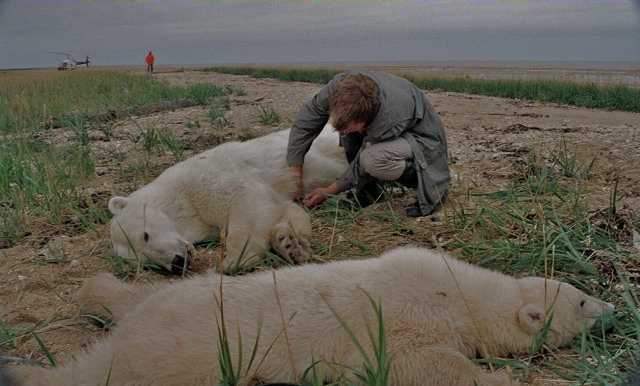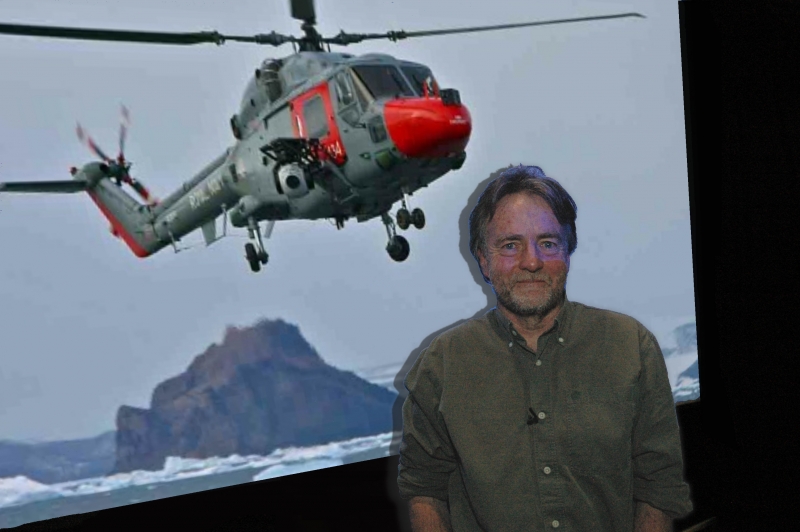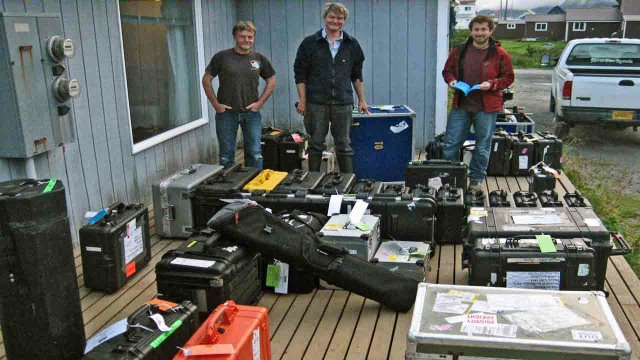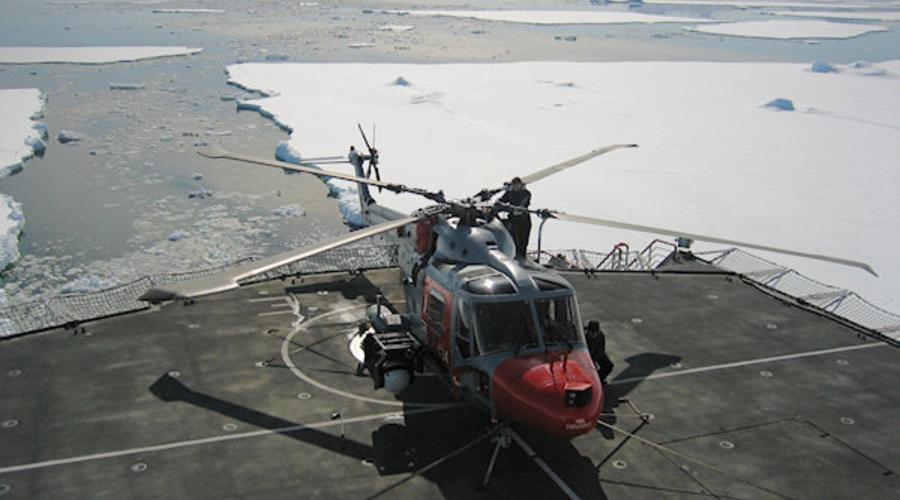When David Baillie’s RTS Masterclass, in association with Newcastle University, had to be postponed due to severe weather, there was the potential for jokes about how a man who’d been to the coldest place on earth would find it a problem to get in from Alston. But Graeme Aldous found it was well worth the wait.
I first got to know David Baillie when we shared a table at the RTS North East & The Border Awards — it must have been some years ago because we were at the Newcastle Civic Centre. As Wildcat Films, his life seemed somewhat glamorous, because he’d not long come back from filming in Africa. I can’t recall whether it was wildlife, or some local unrest — probably the latter, because at his ‘Through a Polar Viewfinder’ presentation, David said that in those days he got himself work by “going and filming somewhere that no-one else wanted to go”. But either way it was very noticeable that he was just as happy to be at home in the South Tyne Valley as he was to be in the exotic hot spots (in both senses of the phrase) of the world — Western Sahara, Nicaragua, Kashmir.
Since then his work has earned him a share in two Emmys, and a Bafta, as well as a Bafta nomination and twelve RTS regional awards, including our Centre Award in 2008, partly for his stunning aerial camerawork for the BBC’s 'Planet Earth 2007'. And it was that aerial work that formed the main part of his presentation.
After years of working in hot climes, he had a yearning to go to the poles, and the opportunity came in 1988 when Wildcat won a Channel 4 commission to make ‘Poisoning the Pole’ — a full-length documentary that looked at the effects of toxic metal fallout on the food chain in the seas round the North Pole. Which is how he came to milk a polar bear…!

The bears are at the top of the food chain, so any environmental pollution builds up in them more than any other species. David showed a sequence filmed from inside a helicopter as a marksman used a dart gun to tranquilise a mother bear and her cub so that samples could be taken. One sample which would give a clear indication of pollution was to strip off a little of the mother’s milk… which was how David was invited to have a go himself. He says that the teats are so far down in the bear’s fur that it’s very difficult… but he managed it. Then he was made a very dubious offer — would he like to see what it tasted like? Probably the only time an Emmy or RTS Award has been given to a man who’s drunk polar bear milk!
And the camerawork from inside a bucking helicopter, over the shoulder of the marksman, was hardly the stuff that would win awards for smoothness. But David had been struck by the luxurious seating that he’d found in some helicopters — why not try and organise things to that he could film high-definition aerial shots, whilst sitting back in the quilted leather luxury? So 6 years ago Wildcat Flying was born.
David invested a considerable amount of money — he said he re-mortgaged the house — in a Gyron stabilised camera housing which would bolt on to a frame on the outside of a helicopter, and be controlled from a glorified game console inside whilst he watched the pictures on a monitor. Inside the housing, tiny gyroscopes sense what the aircraft is doing, and move the camera in the opposite direction — the two movements cancel out, leaving the camera apparently flying smooth and level.
He largely thought he would be doing the odd bit of broadcast footage and corporates — the ‘Passionate Places’ series for ONE North East used his evocative footage — and could stay near to his beloved Tyne Valley. But a chance phone call to the BBC’s Natural History Unit in Bristol offering the camera facility took him much wider than he expected.
They were assembling the ‘Planet Earth’ team, and one piece of wildlife activity they wanted to capture was humpback whales ‘bubble-netting’ — circling a patch of Krill whilst blowing air from their blowholes. The columns of bubbles keep the krill from scattering, and then the whales take it in turns to surge upwards through the ring, scooping up mouthfuls of krill as they rise. It can’t be filmed from a boat or under water because all that can be seen is the bubbles. It had to be from the air, and had never been done.
The team would be based with the Royal Navy Antarctic Ocean Survey ship HMS Endurance, which has two Lynx Mk 3 helicopters modified for working in sub-zero temperatures. Although they are basically a military design, Antarctic treaties mean that they can carry no weaponry. But the BBC were facing a serious problem — they generally hired a Hollywood-based company which used a Cineflex camera mounting. Unfortunately that was stabilised by gyroscopes on which there was a US military export embargo — no way could a Cineflex be mounted on a Royal Navy helicopter in Antarctica. But although David’s Gyron was also American-built, its gyros were manufactured by British Aerospace — there would be no problem if David and his stabiliser were hired for the shoot. He was the right man, with the right kit, at the right time.

Actually, ‘no problem’ is an exaggeration — the certification of the proposed bracket to connect the Gyron to the Lynx took 3 months to plan and approve at RN Yeovilton, required a 26-person team, 430 pages of documentation, and exhaustive testing costing the BBC some 36-thousand pounds. In contrast, David described a subsequent need to fix the Gyron to a Russian military helicopter to film at an Emperor penguin colony where the bracket was designed in sign language, knocked together in a welding shop in half an hour, tested for helicopter stability by lifting off the ground for 15 seconds… and only cost a bottle of vodka!
But once his camera was fitted to the HMS Endurance Lynx, David was ready to film the stunning shots that we associate so much with the BBC’s recent Natural History programmes from the southern polar region… and which we are perhaps in danger now of taking for granted. He demonstrated the incredible efficiency of the stabiliser with a shot of the helicopter itself landing on the deck of Endurance — the horizon remained totally steady throughout the shot, but the ship was rising and falling on the sea, and the helicopter pilot was trying to synchronise… you could see the nose of the Lynx in the corner of the frame, and it appeared to be going up and down in front of the camera, even though they were actually fixed together.
And from that mechanically fluid link came shot after shot of ice floes, ice cliffs, whales, penguins. And so many shots that (like the bubble-netting) could only be appreciated from the air — a penguin colony that, from high enough up, and comparing the distribution of brown juveniles with the white adults, showed that there was a structure to the apparent squawking chaos. He also devised a method of pulling a sequence of still frames from his video that could be stitched together to allow a seal count along a couple of miles of beach — impossible from the ground.

But let’s not think that if you take the right camera, rig, helicopters and pilots to remote places that everything you desire will be filmable. David reckons that the success rate is about 1-in-8 — and many disappointing hours can be spent. Off South Georgia, the ubiquitous krill — in sheer total bulk probably the most prolific species on the planet — form themselves into clusters known as ‘bait balls’. We know that they do it, but it’s never been filmed. David and the Lynx tried for 2 weeks, but never managed to find one.
And he nearly didn’t capture the Stone Roses in concert in Manchester — hired to hover over the stadium to get aerial shots of the band coming on stage, he and his pilot waited and waited… but still the band didn’t appear. Eventually he got a text message asking him to climb to 1500 feet, explaining that the band wouldn’t come on stage because they thought they’d be drowned out by the chopper. Just think about that — these were The Stone Roses!
So, apart from successfully filming krill bait balls, what ambition does David Baillie have now? Refreshingly, it’s to spend a whole year in his garden, watching the seasons come and go across the South Tyne valley. Oh, and to watch them from ground level!
A remarkable modest man, with huge achievements.

